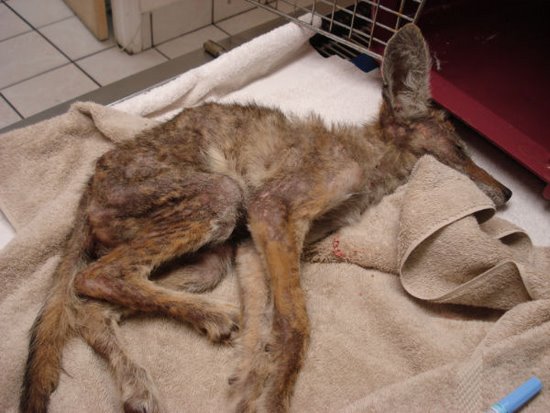The Consequences of Using Rat Poison
by Susan Dickinson
"The degradation of the natural world happens not through the acts of a few evil geniuses but the cumulative effect of billions of individual decisions. It's everyone's fault — and therefore no one's." —Christopher Hume
A Picture Is Worth a Thousand Words
This baby coyote ate a poisoned rodent and would have died a slow agonizing death without the help of S.B. Animal Control, as reported in EdHat.com.  edhat.com/site/tidbit.cfm?id=1553&baseD=daypics2011&card=DSC01985
edhat.com/site/tidbit.cfm?id=1553&baseD=daypics2011&card=DSC01985
Coyotes are predators of rodents, as are hawks, foxes, bobcats, snakes, skunks, and owls. These natural predators keep rodent populations under control. When predators are killed from eating poisoned rats or gophers, the rodent population will increase. The increase in the rodent population usually prompts people to use even more poison. This is not a wise solution.
Consider the findings of a 2005 National Park Service research project by naturalist Seth Riley. Two mountain lions were reported dead due to eating coyotes that had eaten poisoned rodents. Coyotes are a primary food source for mountain lions. The research indicated that suburban development near the Santa Monica Mountains, Simi Hills, and the Santa Susana Mountains, along with pest control substances, caused problems for mountain lions and other predators in that habitat. Scientists from UC Davis concluded that the mountain lions had high levels of anticoagulants in their systems. Anticoagulants are the toxins used in major rodent poisons like d-Con, and cause the blood to thin resulting in death from internal bleeding. According to this report, the two most common anticoagulants are bromadiolone and brodifacoum. Many pesticide companies that service homes for rodent control also use these ingredients.
In the same study, 28 bobcats and 18 coyotes that were tracked died. Of those deaths, six bobcats and five coyotes were killed by vehicles. The rest died from poisoning. “The deaths by car are pretty low, considering how many animals we tracked,” Riley said. “It was the anticoagulants that had a much more devastating effect on the lives of the animals.” Rodents have developed a greater resistance to the poisons, so higher and higher doses are required to kill them. If an average-sized coyote ingests three or four poisoned rodents over a short period of time, there's a good chance these anticoagulants will pass from the poisoned rodent to the coyote, killing it. Some coyotes have been observed ingesting 9-10 rodents a day.
The toxicology reports that were part of the study, showed 80 percent of bobcats tested in the area had some levels of anticoagulants. The study took a dramatic turn in the spring of 2002. A disproportionate number of bobcats were dying from what scientists thought was a form of mange, a typically nonlethal strain of the skin disease that's found primarily in cats. A previously recorded 77 percent chance of survival from year to year for bobcats dropped to 50 percent in 2002 and then to only 20 percent in 2003. Scientists realized bobcats that died of mange also had high levels of anticoagulants in their systems. Together, these two factors caused a nearly 50 percent drop in survival rates for local bobcats in a two-year period.
Dogs and cats are at risk just like coyotes and bobcats. Check out the websites below to learn about the signs of poisoning in dogs and cats: righthealth.com/topic/Rat_Poisoning_In_Dogs#ixzz1SPLvnSey, and for cats: petmd.com/cat/conditions/toxicity/c_ct_bromethalin_rodenticide_toxicity.
Trapping is the alternative to poison, but it can also pose a problem if the traps endanger pets or other wildlife. My husband uses large rat traps, baits them with peanut butter, and places them in areas where rat droppings or activilty can be seen. He puts the traps under milk crates with a heavy brick on top. This allows the rats to go in for the bait, but prevents pets, birds, and other wildlife from getting hurt.
Also is it helps to eliminate food for the rats. At night take in your bird feeder, food for poultry and food for pets. Wrap the base of fruit trees with aluminum sheeting and keep fruit off the ground. Remove vinca and ivy from your property because rats can hide from predators in it. Cut back vegetation that can be a ladder to the roof. Keep lids of trash and garbage containers on tight. A good website to learn about rats, their habits, and how to safely and professionally control them is unitedwildlife.com/animalsrat.html
We can all act to reduce the food source for the rodents as well as protect and coexist with the wildlife in beautiful Mission Canyon.
